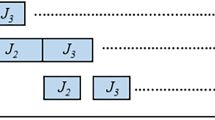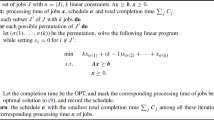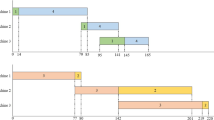Abstract
Partially Concurrent Open Shop Scheduling (PCOSS) is a relaxation of the well-known Open Shop Scheduling (OSS), where some of the operations that refer to the same job may be processed concurrently. Here we extend the study of the PCOSS model by considering an additional resource, which is limited to several units. We deal with the case of preemption PCOSS, where a few polynomial algorithms are known for its OSS counterpart. The scheduling problem is equivalent to the problem of conflict graph colouring. The restriction on the number of resource units bounds the size of colour classes. We thus study the problem of bounded vertex colouring. A new bound for the makespan is presented, and it is shown that for a 2-bounded colouring the bound is attainable. Some insight about a special case of PCOSS, composed of identical jobs, is given. The model correlates to a real-life timetabling project of assigning technicians to vehicles in a garage, with an additional resource, such as vehicle lift.







Similar content being viewed by others
Notes
Vertices that represent operations with zero processing times are omitted.
\(\left\lceil \frac{p}{r}\right\rceil \) distinct colours should be used when non-fractional colouring is applied.
This means that the conflict graphs of any two jobs are isomorphic.
References
Burke, E. K., Elliman, D. G., & Weare, R. F. (1994). A university timetabling system based on graph colouring and constraint manipulation. Journal of Research on Computing in Education, 27(1), 1–18.
Caramia, M., & Dell’Olmo, P. (2001). Solving the minimum-weighted coloring problem. Networks, 38(2), 88–101.
de Werra, D. (1997). Restricted coloring models for timetabling. Discrete Mathematics, 165, 161–170.
de Werra, D., & Blazewicz, J. (1992). Some preemptive open shop scheduling problems with a renewable or a nonrenewable resource. Discrete Applied Mathematics, 35(3), 205–219.
Diestel, R. (2017). Graph theory, volume 173 of graduate texts in mathematics (5th ed.). Berlin: Springer.
Dulmage, A. L., & Mendelsohn, N. S. (1969). Some graphical properties of matrices with non-negative entries. Aequationes mathematicae, 2(2–3), 150–162.
Furmańczyk, H., Jastrzebski, A., & Kubale, M. (2016). Equitable coloring of graphs. Recent theoretical results and new practical algorithms. Archives of Control Sciences, 26(3), 281–295.
Grinshpoun, T., Ilani, H., & Shufan, E. (2014). Partially-concurrent open shop scheduling. In Proceedings of the 10th international conference of the practice and theory of automated timetabling (PATAT) (pp. 188–201).
Grinshpoun, T., Ilani, H., & Shufan, E. (2017). The representation of partially-concurrent open shop problems. Annals of Operations Research, 252(2), 455–469.
Grötschel, M., Lovász, L., & Schrijver, A. (2012). Geometric algorithms and combinatorial optimization, volume 2 of algorithms and combinatorics. Berlin: Springer.
Hansen, P., Hertz, A., & Kuplinsky, J. (1993). Bounded vertex colorings of graphs. Discrete Mathematics, 111(1), 305–312.
Ilani, H., Shufan, E., & Grinshpoun, T. (2016). Partially concurrent open shop scheduling and graph colourings. In Proceedings of the 11th international conference of the practice and theory of automated timetabling (PATAT) (pp. 195–205).
Ilani, H., Shufan, E., & Grinshpoun, T. (2017). Partially concurrent open shop scheduling with integral preemptions. Annals of Operations Research, 259(1–2), 157–171.
Janssen, J., & Kilakos, K. (1999). Bounded stable sets: Polytopes and colorings. SIAM Journal on Discrete Mathematics, 12(2), 262–275.
Klavẑar, S. (1996). Coloring graph products: A survey. Discrete Mathematics, 155(1), 135–145.
Rickman, J. P. (2014). The design of a course-timetabling system using graph-coloring and artificial intelligence. Honors Program Theses, paper 15, Rollins College.
Sabidussi, G. (1957). Graphs with given group and given graph-theoretical properties. Canadian Journal of Mathematics, 9(515), C525.
Scheinerman, E. R., & Ullman, D. H. (2011). Fractional graph theory: A rational approach to the theory of graphs. North Chelmsford: Courier Corporation.
Welsh, D. J. A., & Powell, M. B. (1967). An upper bound for the chromatic number of a graph and its application to timetabling problems. The Computer Journal, 10(1), 85–86.
Author information
Authors and Affiliations
Corresponding author
Additional information
Publisher's Note
Springer Nature remains neutral with regard to jurisdictional claims in published maps and institutional affiliations.
Rights and permissions
About this article
Cite this article
Ilani, H., Grinshpoun, T. & Shufan, E. Bounded colouring motivated by the limited resource partially concurrent open shop problem. Ann Oper Res 302, 461–476 (2021). https://doi.org/10.1007/s10479-019-03503-9
Published:
Issue Date:
DOI: https://doi.org/10.1007/s10479-019-03503-9




